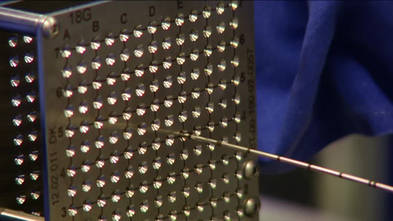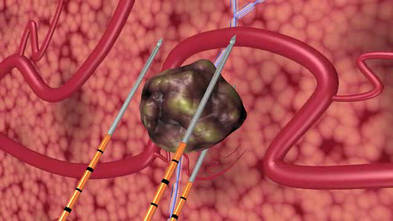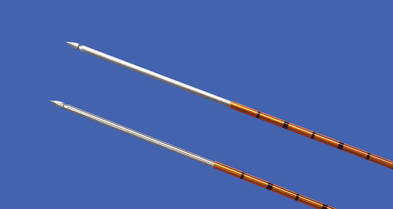The IRE procedure for the treatment of prostate cancer
There are alternatives to a radical prostatectomy (complete surgical removal of the prostate), which are very gentle and minimally invasive.
- Firstly, the HIFU treatment concept. High intensity focused ultrasound waves produce heated areas which destroy the tumour cells in a targeted manner. However, tumours cannot always be treated using this method. For instance, if the prostate is too large or partially calcified. Or if the carcinoma is located outside the range of the ultrasonic waves due to its position or anatomical variations in the prostate. Here, the IRE procedure provides a possible treatment option:
- The irreversible electroporation (IRE) procedure The NanoKnife IRE procedure used in the Heidelberg Clinic for Prostate Therapy was developed by the American company AngioDynamics (New York, USA) and is being used by the Heidelberg urologists for the very first time in Germany as a standardised procedure for the treatment of prostate cancer.
The principle of irreversible electroporation (IRE)
The procedure uses short electrical pulses to effectively destroy cancer cells - a physical effect that has been known for decades. The impulses which have differing strengths and last for only a few microseconds, open pores in the cells in the treatment area and this causes the cells to die. This is also where the term "NanoKnife" originates from - a kind of "electronic scalpel" that opens the cell membrane.
What is special about this method of treatment is that the pulses are extremely short and it does not generate heat. This means that the cell matrix of the healthy tissue in the area of treatment remains preserved and is able to regenerate itself: the healthy tissue grows again without any problem and the healthy areas of the prostate such as blood vessels and other ducts are preserved to the greatest possible extent. The dead cancer cells are replaced by healthy cells as part of the body's natural growth process.

Graphics: Clinic for Prostate Therapy / AngioDynamics
Treatment
If the suspicion of cancer is confirmed following extensive investigations, such as the MRI-guided biopsy, and the tumour areas have been located, the doctor and patient will decide together on the appropriate treatment.
Before IRE treatment takes place, a routine examination is carried out to assess suitability for anaesthesia, and from the day before the procedure a light prophylactic antibiotic treatment is given. The patient is fitted with a urinary catheter to protect the urethra and to prevent urinary retention. Following successful treatment, the urinary catheter can usually be removed just a few days after treatment.
An MRI-guided biopsy enables the precise location of the tumour(s) to be identified. The needle-like probes, between which the electrical field is created, are then placed around the diseased areas of the prostate. This is carried out via a template, which is securely attached to the treatment table and enables the urologist carrying out the procedure to insert the needles with pinpoint accuracy. The template enables the IRE needles to be positioned with high precision. The template has a coordinate system and it also has holes through which needles are inserted for tissue removal in the case of an MRI-guided biopsy, or in the case of IRE treatment, the electrical probes are inserted into the prostate. The quantity and the position of the probes depend on the size and position of the tumour. The procedure is performed with the patient under general anaesthesia, so that the success of the treatment is not affected by movements of the patient.

Photo: Clinic for Prostate Therapy

Graphics: Clinic for Prostate Therapy/ AngioDynamics

Photo: Clinic for Prostate Therapy / AngioDynamics
The IRE treatment in videos
Depending on the size of the tumour, between two and six needles are required. Larger tumours can also be treated. When the needles are positioned around the tumour, high-voltage impulses of 70 microseconds (µs) in length are emitted, which are repeated every 100 to 1,000 milliseconds (ms). They create short currents of around 50 amperes. The electrical impulses open the cell membranes by creating tiny holes, known as nanopores. The cell then dies. The field strength and impulse length are set so that no heat is generated - therefore the cells are not destroyed by heat, but by the electrical field of the NanoKnife which opens the cell membrane.
The procedure enables the healthy tissue in the treatment area to completely regenerate after a short time, whilst the cancerous tissue is completely destroyed. In this way, important functions of the prostate are maintained. Depending on the location of the prostate tumour, it is possible to protect the potency nerves so that impotence can be avoided. Following treatment, many patients feel a fleeting muscle ache as the electrical impulses have activated the leg and pelvis muscles. In most cases, the catheter can be removed just a few days after treatment and the patient can leave the clinic after just one night’s stay under medical supervision.
As with all tumours, close monitoring is also required after therapy in the case of prostatic carcinomas. It is not only a way of monitoring the success of the treatment, but also allows early recognition of possible complications which in most cases can be successfully resolved. Possible temporary impotence or incontinence is rare, but cannot be ruled out 100 percent. However, these symptoms usually disappear after a few weeks - if they occur at all. A follow-up examination is carried out after one month and then every three to six months during the first year following treatment.
The NanoKnife System has received FDA (US Food and Drug Administration) clearance for the surgical ablation of soft tissue. It has not received clearance for the therapy or treatment of any specific disease or condition. [510(k) Number: K080376].
The Clinic for Prostate Therapy is the only clinic in Germany where the urologists use the procedure as a standard therapy for prostate cancer.
HÄUFIG GESTELLTE FRAGEN ZUM THEMA IRE UND IRREVERSIBLE ELEKTROPORATION BEI PROSTATAKREBS
Wofür steht der Begriff IRE?
IRE ist die Abkürzung von „Irreversible Elektroporation“. Dieser Begriff steht für eine fokale, zielgerichtete und schonende Behandlung von Prostatakrebs mit ultrakurzen Spannungs- und Stromimpulsen.
Was bedeutet Irreversible Elektroporation?
Urologen nutzen das IRE-Verfahren, um ohne chirurgischen Schnitt und allein mit extrem kurzen elektrischen Spannungs- und Stromimpulsen Tumorgewebe in der Prostata zu zerstören.
Was bedeutet NanoKnife?
Das NanoKnife ist die umgangssprachliche Bezeichnung für die Methode der Irreversiblen Elektroporation (IRE). Ein sinnbildlich „elektronisches Messer“ in der Hand des Arztes bringt Tumorzellen in der Prostata zum Absterben.
Für welche Fälle eignet sich das IRE-Verfahren?
Das Verfahren eignet sich sowohl für die Erstbehandlung von Prostatakrebs als auch zur Anwendung nach einer erfolglosen Strahlentherapie, wenn Rezidive aufgetreten sind. In den USA werden mit IRE schon seit einigen Jahren verschiedene Tumorformen behandelt, in Deutschland wird das Verfahren bisher nur sehr selten eingesetzt.
Ist das IRE-Verfahren zugelassen?
Das IRE-Verfahren mit dem NanoKnife hat eine Zulassung der amerikanischen Arzneimittelbehörde FDA.
Wie funktioniert die Irreversible Elektroporation?
In der Regel werden zwei bis sechs Elektroden mit hoher Genauigkeit über eine Metallschablone in die Prostata geführt, nachdem Lage und Größe des Tumors mit einer Kombination aus Ultraschall und Magnetresonanztomographie (MRT) festgestellt wurden. Über diese Elektroden werden gepulste elektrische Felder lokal eng begrenzt und zielgerichtet („fokal“) auf den Tumor gerichtet. Die kurzen Stromstöße machen die Zellmembran durchlässig. Es entstehen so genannte Nano-Poren, die zum Tod der Krebszellen führen, während sich das umliegende gesunde Gewebe rasch wieder erholt.
Eignet sich das IRE-Verfahren für alle Arten von Prostatakarzinomen?
Mit dem IRE-Verfahren und dem NanoKnife lassen sich Tumoren behandeln, die aufgrund ihrer Größe, ihrer Lage oder des hohen Verkalkungsgrades der Prostata bisher nicht fokal mit Ultraschall (HIFU-Verfahren) behandelt werden konnten.
Mit welchen Folgen ist nach einer IRE-Behandlung zu rechnen?
Nach jeder Tumorbehandlung wird eine sorgfältige Nachsorge durchgeführt, um den Heilungserfolg zu überwachen. Selten tritt vorübergehend Impotenz oder Inkontinenz auf. Diese Symptome – falls sie überhaupt auftreten – verschwinden meist nach wenigen Wochen. Einen Monat nach der Behandlung gibt es eine erste Nachuntersuchung, dann, im ersten Jahr, alle drei bis sechs Monate.
